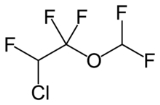
Enflurane
Encyclopedia
Enflurane is a halogenated ether
that was commonly used for inhalational anesthesia
during the 1970s and 1980s. Developed by Ross Terrell in 1963, it was first used clinically in 1966.
Enflurane is a structural isomer
of isoflurane
. It vaporizes readily, but is a liquid at room temperature.
with an associated decrease in myocardial oxygen consumption. Between 2% and 5% of the inhaled dose is oxidised in the liver, producing fluoride
ions and difluoromethoxy-difluoroacetic acid. This is significantly higher than the metabolism of its structural isomer isoflurane
.
Enflurane also lowers the threshold for seizures, and should especially not be used on people with epilepsy
. It is also known to cause malignant hyperthermia
.
It relaxes the uterus in pregnant women.
Enflurane and methoxyflurane
have a nephrotoxic effect and cause acute renal failure, usually by its nephrotoxic metabolite.
Halogenated ether
A halogenated ether is a subcategory of a larger group of chemicals known as ethers. An ether is an organic chemical that contains an ether group — an oxygen atom connected to two alkyl groups...
that was commonly used for inhalational anesthesia
Anesthesia
Anesthesia, or anaesthesia , traditionally meant the condition of having sensation blocked or temporarily taken away...
during the 1970s and 1980s. Developed by Ross Terrell in 1963, it was first used clinically in 1966.
Enflurane is a structural isomer
Isomer
In chemistry, isomers are compounds with the same molecular formula but different structural formulas. Isomers do not necessarily share similar properties, unless they also have the same functional groups. There are many different classes of isomers, like stereoisomers, enantiomers, geometrical...
of isoflurane
Isoflurane
Isoflurane is a halogenated ether used for inhalational anesthesia. Together with enflurane and halothane, it replaced the flammable ethers used in the pioneer days of surgery. Its name comes from being a structural isomer of enflurane, hence they have the same empirical formula...
. It vaporizes readily, but is a liquid at room temperature.
Physical properties
| Property | Value |
|---|---|
| Boiling point Boiling point The boiling point of an element or a substance is the temperature at which the vapor pressure of the liquid equals the environmental pressure surrounding the liquid.... at 1 atm Atmosphere (unit) The standard atmosphere is an international reference pressure defined as 101325 Pa and formerly used as unit of pressure. For practical purposes it has been replaced by the bar which is 105 Pa... |
56.5 °C |
| MAC Minimum alveolar concentration Minimum alveolar concentration or MAC is a concept used to compare the strengths, or potency, of anaesthetic vapours; in simple terms, it is defined as the concentration of the vapour in the lungs that is needed to prevent movement in 50% of subjects in response to surgical stimulus... |
1.68 |
| Vapor pressure Vapor pressure Vapor pressure or equilibrium vapor pressure is the pressure of a vapor in thermodynamic equilibrium with its condensed phases in a closed system. All liquids have a tendency to evaporate, and some solids can sublimate into a gaseous form... at 20 °C |
22.9 kPa (172 mm Hg Torr The torr is a non-SI unit of pressure with the ratio of 760 to 1 standard atmosphere, chosen to be roughly equal to the fluid pressure exerted by a millimetre of mercury, i.e., a pressure of 1 torr is approximately equal to 1 mmHg... ) |
| Blood: Gas Partition Coefficient | 1.9 |
| Oil: Gas Partition Coefficient | 98 |
Side effects
Clinically, enflurane produces a dose-related depression of myocardial contractilityContractility
Myocardial contractility is the intrinsic ability of the heart to contract independent of preload and afterload. Changes in the ability to produce force during contraction result from different degrees of binding between myosin and actin filaments...
with an associated decrease in myocardial oxygen consumption. Between 2% and 5% of the inhaled dose is oxidised in the liver, producing fluoride
Fluoride
Fluoride is the anion F−, the reduced form of fluorine when as an ion and when bonded to another element. Both organofluorine compounds and inorganic fluorine containing compounds are called fluorides. Fluoride, like other halides, is a monovalent ion . Its compounds often have properties that are...
ions and difluoromethoxy-difluoroacetic acid. This is significantly higher than the metabolism of its structural isomer isoflurane
Isoflurane
Isoflurane is a halogenated ether used for inhalational anesthesia. Together with enflurane and halothane, it replaced the flammable ethers used in the pioneer days of surgery. Its name comes from being a structural isomer of enflurane, hence they have the same empirical formula...
.
Enflurane also lowers the threshold for seizures, and should especially not be used on people with epilepsy
Epilepsy
Epilepsy is a common chronic neurological disorder characterized by seizures. These seizures are transient signs and/or symptoms of abnormal, excessive or hypersynchronous neuronal activity in the brain.About 50 million people worldwide have epilepsy, and nearly two out of every three new cases...
. It is also known to cause malignant hyperthermia
Malignant hyperthermia
Malignant hyperthermia or malignant hyperpyrexia is a rare life-threatening condition that is usually triggered by exposure to certain drugs used for general anesthesia; specifically, the volatile anesthetic agents and the neuromuscular blocking agent, succinylcholine...
.
It relaxes the uterus in pregnant women.
Enflurane and methoxyflurane
Methoxyflurane
Methoxyflurane is a halogenated ether that was in clinical use as an volatile inhalational anesthetic from its introduction by Joseph F. Artusio et al in 1960 until around 1974. It was first synthesized in the late 1940s by William T...
have a nephrotoxic effect and cause acute renal failure, usually by its nephrotoxic metabolite.

